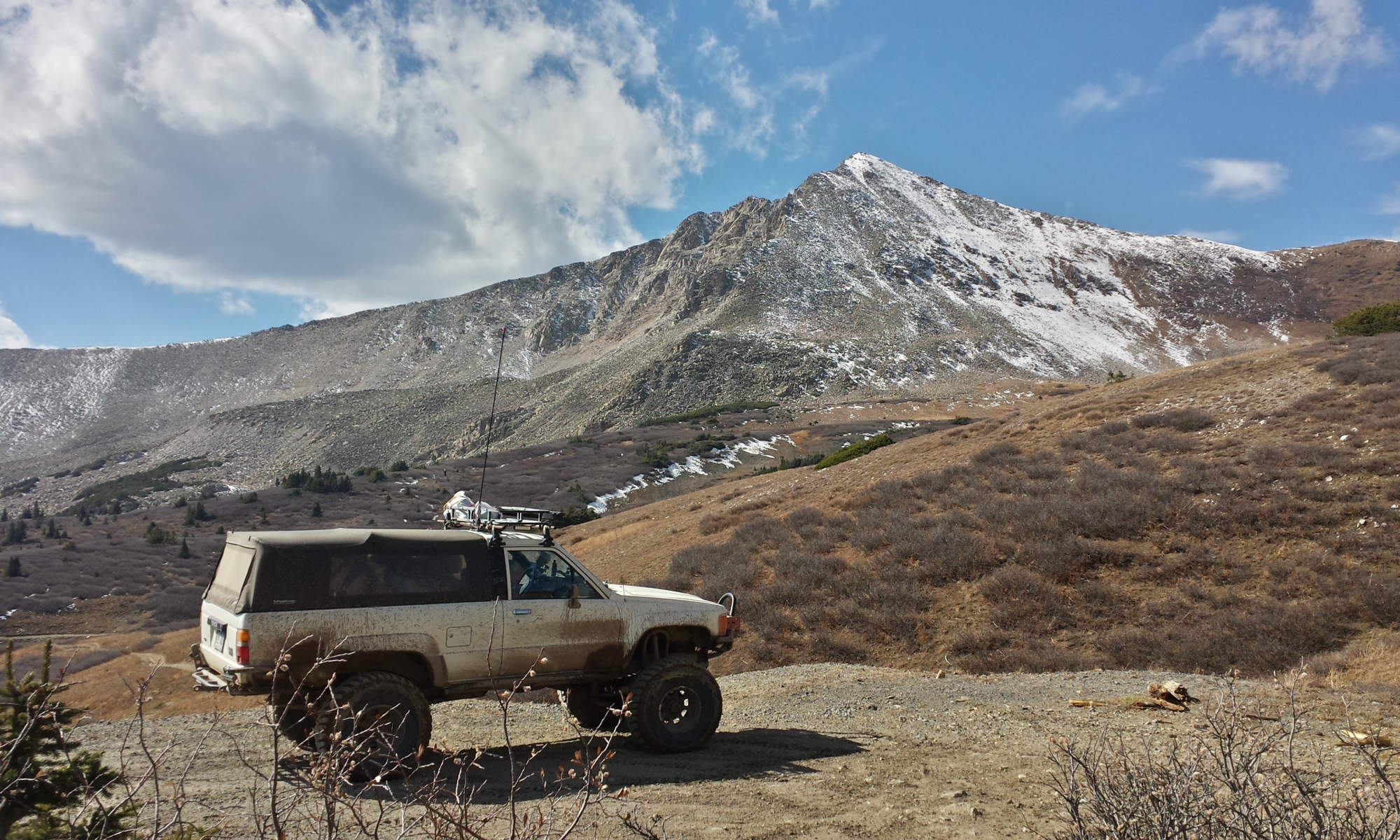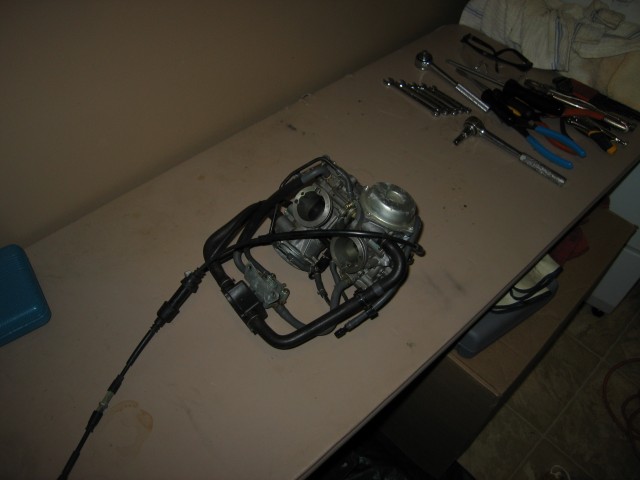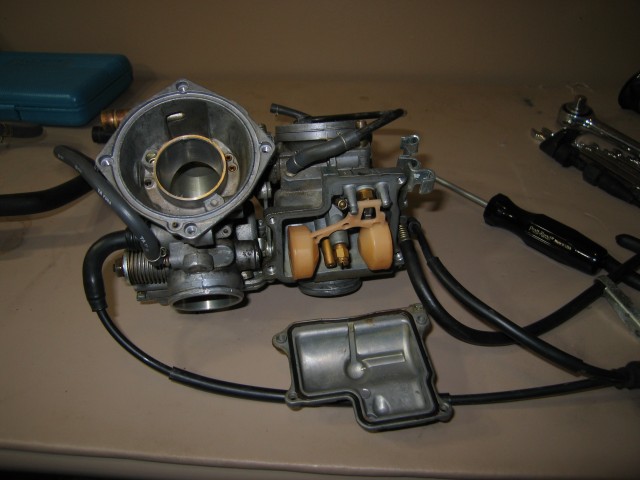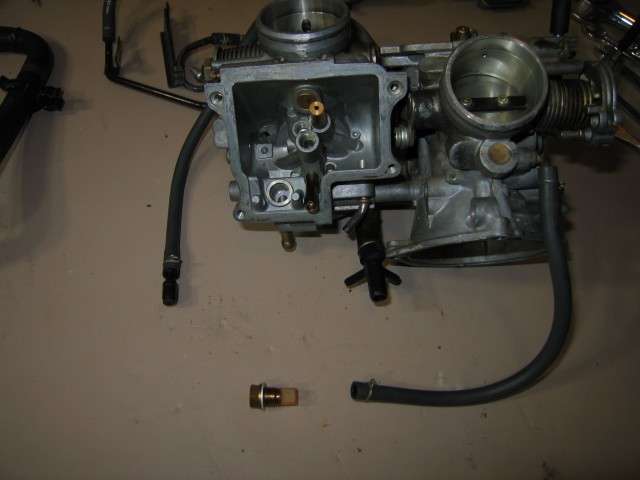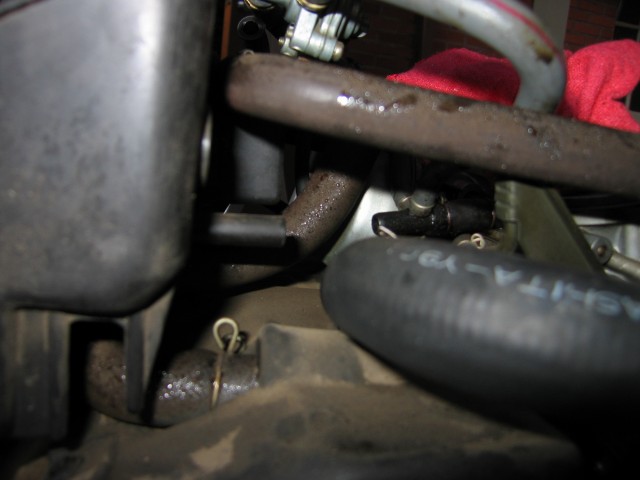While I was working on my PC800 the other day I discovered that the carbs had gotten gummed up while it’s been sitting. This is the result. Fuel leaking out of the plastic tree between the two carb bodies. I pulled the bodies off of the bike, opened the float bowls, cleaned out a little bit of gunk that had built up and exercised the floats, put it back together, and it was fine. This is usually an indication of a stuck float valve or a flooded float body. It’s an easy enough fix to do in an afternoon.
PC800 carburettor tear-apart
Tonight I disassembled the spare set of PC800 carburettors that I acquired from Phil for the PC800 fuel injection project. Here the carbs sit in their whole state.
I took out the diaphragms first. Careful that spring doesn’t sproing away when you open these up!
I think the diaphragms were replaced in the not-too-distant past. They were in pretty good shape. No signs of fatigue or cracking. Nice and pliable.
Two sets of diaphragms. One of the lids had a stubborn screw to get loose. It took a pair of vice grips to get it to turn. Also there was one oddball screw that was shorter than the rest. I suspect that it was serviced at some point and an incorrect screw was put back on.
Now for the float bowls. These floats look pretty nice. Everything was nice and clean inside with no signs of gunk or crud. The seal on the lid could stand to be replaced though.
These are the pneumatic lines that run from the “Christmas tree” thing in the middle of the carbs back to where they connect to the float bowls. It looks like they just help to keep the air pressure neutral with atmosphere. That’s just speculation though.
The Christmas tree is that big black piece of plastic just above the Stanley screw driver handle. The two larger hoses that snake back into the carbs (you can’t see it from this picture) supply air to the carbs when the choke cable is pulled open. I have read on the PC800 listserv that the choke cable actually is an enrichment circuit though. However, when the choke is open, the open end of the “Christmas tree” sucks in a lot of air (it’s audible). If you plug it off with your hand, the speed of the engine changes when the choke is open.
This is the filter and valve on the fuel supply that is operated by the floats in the float bowl (it’s in the lower center of the photograph, made out of brass). There is a filter on the end of it. The filters in this set of carbs where whistle clean.
I’m thinking about putting secondary injectors into the hole left by the diaphragms. Otherwise, I’ll close off these holes with some JB Weld. The secondary injectors would only kick on at high RPM when the air would be flowing fast enough to not matter too much where the injectors are aimed.
I’m planning to place the primary injectors here. Well, imagine them in the carbs about an inch further. There is a very small hole (not the vacuum hole) that appears to lead toward the float bowls. I plan to drill out the carbs there and install a fuel injection bung.
Here’s another angle. I can turn the injector plug to the side in order to clear the engine heads. The guts of the float bowls that I wasn’t able to remove (some brass tubes and the cast aluminum) will have to be cut out of the way. I believe my Dremel tool will be the best choice for that. In order to drill out and seat the injector bungs, I am probably going to need to develop some sort of wooden jig to hold the carbs at the proper angle so I can use a drill press. Or I could try my luck with some C clamps and a hand-held drill. In order to hold the injector bungs in place, I am planning to use JB Weld. The Holley fuel injector bung installation guide even recommends JB Weld for such applications. I plan to use JB Weld to seal up all the other miscellaneous holes left in the carbs. The holes for the choke cables and the large hoses coming of the “Christmas tree” perplex me though. I haven’t quite decided if they should be sealed or left open or what. There are a lot of intricate bits to these carburetters that I still don’t understand. All I need them to do is act like throttle bodies, provide a source of vacuum (in case I want cruise control someday and for an idle air control valve), and be a home for the fuel injectors.
One thing I haven’t figure out yet is how to secure the fuel rail (and thus the injector) to the carbs. On the CBR600RR throttle bodies, the fuel rails were secured directly using screws. That won’t be a very easy option in this case. I am going to have to find new fuel rails anyway (nothing will line up to allow me to reuse the existing rails) so perhaps I can come up with some clamps or brackets that I can tie into the gutted PC800 carbs. Otherwise without some sort of restraint, I suspect that the fuel rails will quickly squirt off of the injectors and lead to a potentially nasty engine fire.
This is my “workshop.” I live in a fraternity where the food is provided. Therefore, the kitchen in my apartment has been turned into a motorcycle workshop. It’s better than when I had a much larger table setup in my living room. I finally reclaimed that space and compacted my project space so I can do morning exercises without banging my head on wayward fuel tanks.
Speaking of fuel tanks, I have yet to contract someone to weld on the spare PC800 tank. It’s on the to-do list but I’m often busy during normal business hours. Perhaps this week I can get the tanks over to a local welder for an appraisal. I’ve been toying with the idea of doing it myself with JB Weld or Water Weld. Both are rated for fuel tank use. Actually… that’s not such a bad idea… And it’s a heck of a lot less risky than lighting things on fire around fuel vapor.
Am I missing a hose or three on my PC800?
NEWER UPDATE: The hose barb that dumped all the fuel out would connect to the evaporative emissions control on a California emissions-equipped bike. Page 5-6 in the service manual shows the way the hoses should be setup.
UPDATE: There were no hoses missing from my 49 state 1989 Pacific Coast. I am told that it is supposed to be this way. And the bike runs just fine. Check out this thread and this post from the IPCRC for more information.
This morning while I was pulling the carbs off my bike I noticed what appears to be some missing hoses. In fact, one of the bare hose barbs even dumped a bunch of fuel out when I pulled the carbs off. Anyone know if there should be hoses on these barbs and where those hoses should go? The bike has run just fine since I bought it 1000 miles ago. Maybe I should just let sleeping dogs lay?
My finger is pointing toward a bare hose barb. It is open to the other hoses. When I pulled the carbs off, a bunch of gas dumped out of this barb. The hoses that branch off from this barb go to both carbs. Update: that weird T thing is where all of the vacuum hoses come together on the carbs.
Another view looking from the right side of the bike. There is also a barb with no hose on the plastic part where our trunk release and gas cap live. It is visible on the lower front of that assembly (the left side of the photo). It is in front of a brown hose with some condensation on it. It is the same size as the barb on that multi-T thing which is at the same height in this photo and just to the right of center in the picture.
This is looking from the right side of the bike. My finger is pointing toward a little metal tube that comes off of the carb and goes into a rubber hose that appears to be broken off. Is that supposed to be that way? Maybe it’s just a plug or something? The carbs are several blocks away (internet is out at the house) so I can’t look on the other carb to see if there is a similar setup or if it is unique to this carb. Also can’t tell you if it is a plug or open. Yeah, not to prepared this time 🙂
